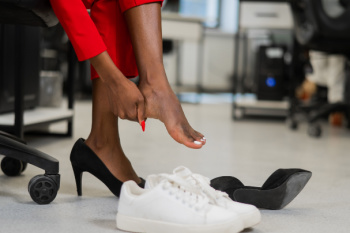Connect With Us
Blog
Items filtered by date: January 2025
What Is Iselin's Disease and Who Does It Affect?

Iselin's disease is a condition that affects the growth plate of the fifth metatarsal bone, located in the foot. It typically occurs in children and adolescents, especially those who are physically active and participate in sports such as running or jumping. The condition is more common in girls aged eight to 13 and boys aged 10 to 14. Iselin's disease is characterized by pain and tenderness on the outside of the foot, near the base of the pinky toe. The pain may worsen with physical activity and improve with rest. Swelling and bruising may also be present in some cases. The exact cause of Iselin's disease is not fully understood, but it is believed to result from repetitive stress or overuse, which leads to inflammation of the growth plate. Treatment typically involves rest, and, in some cases, the use of supportive footwear or orthotics to reduce stress on the affected area. If your active child has foot pain, it is suggested that you consult a podiatrist who can provide an accurate diagnosis and offer viable treatment and relief options.
Making sure that your children maintain good foot health is very important as they grow. If you have any questions, contact one of our podiatrists of Palm Beach Foot & Ankle. Our doctors can provide the care you need to keep you pain-free and on your feet.
Keeping Children's Feet Healthy
Having healthy feet during childhood can help prevent medical problems later in life, namely in the back and legs. As children grow, their feet require different types of care. Here are some things to consider...
Although babies do not walk yet, it is still very important to take care of their feet.
Avoid putting tight shoes or socks on his or her feet.
Allow the baby to stretch and kick his or her feet to feel comfortable.
As a toddler, kids are now on the move and begin to develop differently. At this age, toddlers are getting a feel for walking, so don’t be alarmed if your toddler is unsteady or ‘walks funny’.
As your child gets older, it is important to teach them how to take care of their feet.
Show them proper hygiene to prevent infections such as fungus.
Be watchful for any pain or injury.
Have all injuries checked by a doctor as soon as possible.
Comfortable, protective shoes should always be worn, especially at play.
If you have any questions please feel free to contact our offices located in Boynton Beach, Palm Beach Gardens, and West Palm Beach, FL . We offer the newest diagnostic and treatment technologies for all your foot and ankle needs.
Plantar Fasciitis and How It Is Diagnosed

Plantar fasciitis is a common foot condition that causes inflammation of the plantar fascia, the thick band of tissue that runs along the bottom of the foot, connecting the heel to the toes. The main symptom is sharp heel pain, especially when taking the first few steps in the morning or after prolonged periods of sitting. The pain tends to decrease with activity but may return after standing for long periods. Common causes of plantar fasciitis include repetitive strain from activities like running, standing for extended periods, or wearing improper footwear. Other risk factors include obesity, tight calf muscles, and flat feet. To diagnose plantar fasciitis, a doctor will conduct a physical examination and may ask about activity levels and footwear. In some cases, X-rays or an MRI scan may be used to rule out other conditions. Plantar fasciitis can cause severe pain and discomfort. If you have heel pain, it is suggested that you promptly consult a podiatrist who can accurately diagnose and treat plantar fasciitis.
Plantar fasciitis can be very painful and inconvenient. If you are experiencing heel pain or symptoms of plantar fasciitis, contact one of our podiatrists from Palm Beach Foot & Ankle. Our doctors can provide the care you need to keep you pain-free and on your feet.
What Is Plantar Fasciitis?
Plantar fasciitis is the inflammation of the thick band of tissue that runs along the bottom of your foot, known as the plantar fascia, and causes mild to severe heel pain.
What Causes Plantar Fasciitis?
- Excessive running
- Non-supportive shoes
- Overpronation
- Repeated stretching and tearing of the plantar fascia
How Can It Be Treated?
- Conservative measures – anti-inflammatories, ice packs, stretching exercises, physical therapy, orthotic devices
- Shockwave therapy – sound waves are sent to the affected area to facilitate healing and are usually used for chronic cases of plantar fasciitis
- Surgery – usually only used as a last resort when all else fails. The plantar fascia can be surgically detached from the heel
While very treatable, plantar fasciitis is definitely not something that should be ignored. Especially in severe cases, speaking to your doctor right away is highly recommended to avoid complications and severe heel pain. Your podiatrist can work with you to provide the appropriate treatment options tailored to your condition.
If you have any questions please feel free to contact our offices located in Boynton Beach, Palm Beach Gardens, and West Palm Beach, FL . We offer the newest diagnostic and treatment technologies for all your foot and ankle needs.
Heel Pain in the Morning?
Understanding Sever's Disease

Sever's disease, also known as calcaneal apophysitis, is a source of heel pain in growing children and adolescents. It is particularly common among those involved in sports with a lot of running, like soccer, or basketball. It occurs when the growth plate in the heel becomes irritated or inflamed due to repetitive stress, often worsened by activities that involve running or jumping. The main symptoms of Sever's disease include heel pain, tenderness, and swelling at the back of the heel, especially after physical activity. Children may also limp or complain of discomfort when walking or standing for long periods. Treatment typically focuses on relieving pain and reducing inflammation. This may include rest and stretching exercises for the Achilles tendon. Custom orthotics or heel pads can also help reduce pressure on the heel. In severe cases, a podiatrist may recommend a period of restricted activity. If your child is dealing with this condition, it is suggested that you schedule an appointment with a podiatrist.
Sever's disease often occurs in children and teens. If your child is experiencing foot or ankle pain, see one of our podiatrists from Palm Beach Foot & Ankle. Our doctors can treat your child’s foot and ankle needs.
Sever’s Disease
Sever’s disease is also known as calcaneal apophysitis, which is a medical condition that causes heel pain I none or both feet. The disease is known to affect children between the ages of 8 and 14.
Sever’s disease occurs when part of the child’s heel known as the growth plate (calcaneal epiphysis) is attached to the Achilles tendon. This area can suffer injury when the muscles and tendons of the growing foot do not keep pace with bone growth. Therefore, the constant pain which one experiences at the back of the heel will make the child unable to put any weight on the heel. The child is then forced to walk on their toes.
Symptoms
Acute pain – Pain associated with Sever’s disease is usually felt in the heel when the child engages in physical activity such as walking, jumping and or running.
Highly active – Children who are very active are among the most susceptible in experiencing Sever’s disease, because of the stress and tension placed on their feet.
If you have any questions, please feel free to contact our offices located in Boynton Beach, Palm Beach Gardens, and West Palm Beach, FL . We offer the newest diagnostic and treatment technologies for all your foot and ankle injuries.
Causes and Diagnosis of Foot Stress Fractures

A stress fracture in the foot is a hairline crack in a bone, often caused by repetitive stress or overuse. This condition is common among athletes, particularly runners, and can also affect individuals who suddenly increase their activity level or engage in high-impact sports. The primary cause is the continuous pressure placed on the foot without adequate rest, leading to bone fatigue. Symptoms of a stress fracture typically include localized pain, swelling, and tenderness, especially during activity. The pain may initially subside with rest but return when activity resumes. To diagnose a stress fracture, a podiatrist will perform a physical exam and may use imaging tests, such as MRI scans to confirm the injury. Early diagnosis is essential to prevent further damage and ensure proper healing through rest, immobilization, or other treatments. If you have foot pain, it is suggested that you contact a podiatrist who can accurately provide a diagnosis and treatment.
Stress fractures occur when there is a tiny crack within a bone. To learn more, contact one of our podiatrists from Palm Beach Foot & Ankle. Our doctors can provide the care you need to keep you pain free and on your feet.
How Are They Caused?
Stress fractures are the result of repetitive force being placed on the bone. Since the lower leg and feet often carry most of the body’s weight, stress fractures are likely to occur in these areas. If you rush into a new exercise, you are more likely to develop a stress fracture since you are starting too much, too soon. Pain resulting from stress fractures may go unnoticed at first, however it may start to worsen over time.
Risk Factors
- Gender – They are more commonly found in women compared to men.
- Foot Problems – People with unusual arches in their feet are more likely to develop stress fractures.
- Certain Sports – Dancers, gymnasts, tennis players, runners, and basketball players are more likely to develop stress fractures.
- Lack of Nutrients – A lack of vitamin D and calcium may weaken the bones and make you more prone to stress fractures
- Weak Bones – Osteoporosis can weaken the bones therefore resulting in stress fractures
Stress fractures do not always heal properly, so it is important that you seek help from a podiatrist if you suspect you may have one. Ignoring your stress fracture may cause it to worsen, and you may develop chronic pain as well as additional fractures.
If you have any questions, please feel free to contact our offices located in Boynton Beach, Palm Beach Gardens, and West Palm Beach, FL . We offer the newest diagnostic and treatment technologies for all your foot care needs.

